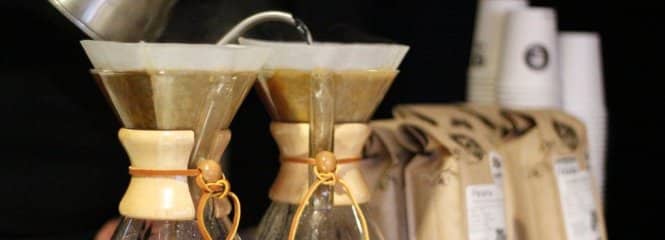Both of the devices we will be discussing in this article are brand names exclusives. The Chemex is continues to be manufactured by the Chemex Coporation in Massachusetts and the Aeropress is a part of the Aerobie company. Again, both of these devices require a very hands-on interaction from the user, and it is maybe this factor which makes them stand out from all other methods available.
The Chemex Coffeemaker is a glass flask with a narrow waist. The opening is as wide as the flask itself and is where the coffee filters are placed. These filters are specially made for this gadget from a thicker, chemically bonded paper than those made for an automatic drip coffee maker. And it is in the filters where the secret to the Chemex hides, since its where something different occurs. These special filters prevent most of the coffee oils to filter through the brew itself, resulting in a different taste. Plus, cafestol -a compound present in coffee and coffee oil that elevates cholesterol- is removed as well.
The filter is placed in the neck and enough water to let it bloom is poured. Once the beans are moist, the rest of the hot water will be poured over them. All is left to do is wait until the dripping starts and finishes. A useful tip is to keep in mind that, in order to be able to serve the coffee, the filter with its contents must be removed, so keeping a separate vessel nearby for this residue might be a good idea.
When it comes to the Aeropress, we find ourselves before a fairly new and novel artifact. Basing its mechanism in that of a medical syringe, the Aeropress is made up by two cylinders, one inside of the other. Finely ground coffee needs to be placed inside the wider cylinder, which is the one that goes in the bottom of the device itself and above the mug or vessel that is going to house the coffee. Once the beans are in place, hot (but never boiling) water is poured and the mixture must be stirred for approximately ten seconds before securing in place the upper cylinder and forcing the mixture through the embedded microfilter. The plunger is pushed downwards as the coffee is decanted to the mug.
Technical differences between these two devices lie in the different filters they use and the coarseness of the bean itself. Though both call for the use of a finely ground bean, the one used by the Aeropress is, more often than not, slightly finer.
These two brewing methods are great for coffee lovers that are always looking for new and improved ways to prepare their beverages, and both gadgets are designed in such a way that they are in themselves novelties and icebreakers. Both produce strong and robust beverages, so there is not a real difference in that department. As always, it is reduced to the user’s taste and personal preferences.
